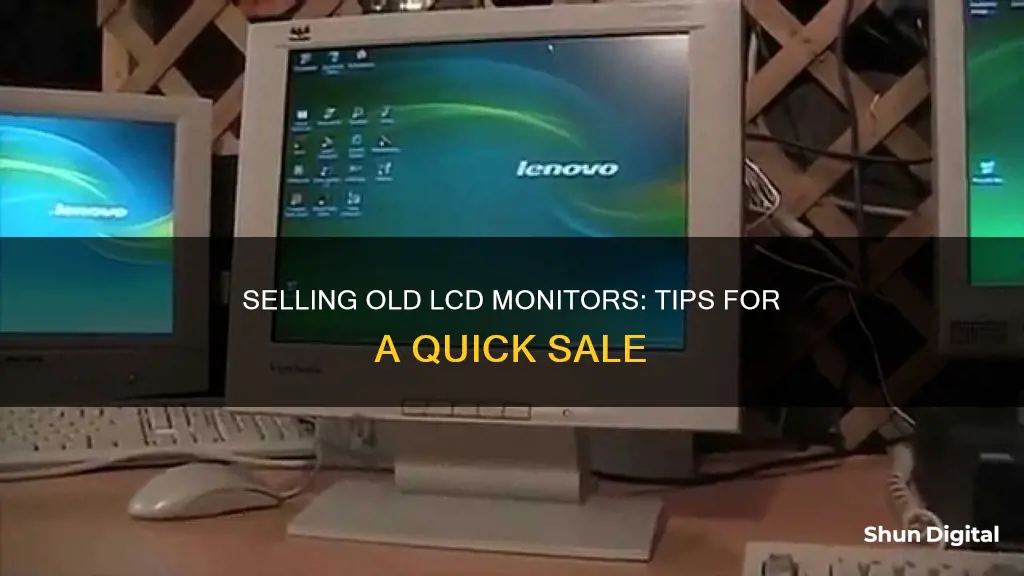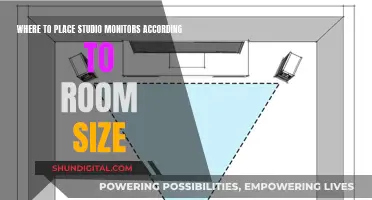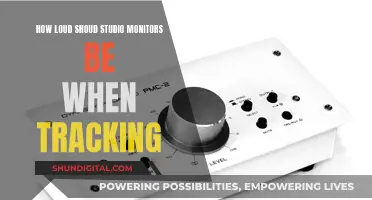
If you're looking to sell an old LCD monitor, there are a few options available to you. You can try selling it online on websites such as OLX, Quikr, or Cashify, which are popular platforms for buying and selling used electronics in India. These websites allow you to post your item for sale and connect with potential buyers directly. Alternatively, you can try contacting local computer stores or electronics retailers, as they may be interested in purchasing your old monitor, especially if it's still in good working condition. When selling your old LCD monitor, it's important to be honest about the condition of the item and provide detailed information about any cosmetic wear or functional issues. You should also be prepared to negotiate on the price, as buyers may try to haggle.
| Characteristics | Values |
|---|---|
| Selling platforms | Cashify, OLX |
| Price | Varies depending on the condition and specifications of the monitor |
| Payment method | Cash |
| Pick-up | Free doorstep pick-up |
What You'll Learn

Preparing your LCD monitor for sale
If you're looking to sell your old LCD monitor, there are a few things you can do to prepare it for sale and get the best price. Here are some steps you can follow:
- Clean your monitor: Give your LCD monitor a thorough cleaning to make it look as presentable as possible. Use a soft, dry cloth to wipe down the screen and exterior casing, removing any dust, dirt, or fingerprints. You can also use a mild cleaning solution, such as a 50/50 mixture of water and isopropyl alcohol, but be sure to apply it to the cloth and not directly to the screen. Avoid using paper towels or abrasive cleaning materials, as they may scratch the surface.
- Inspect the monitor for damage: Look for any scratches, scuffs, or other signs of wear and tear on the monitor. If there are minor issues, you may be able to repair them yourself with the right tools and supplies. For more significant damage, consider disclosing it to potential buyers, as honesty can build trust.
- Test the monitor's functionality: Ensure that all the features of your LCD monitor are in working order. Test the power, brightness, colour accuracy, and responsiveness of the display. Check for dead pixels, input lag, or other technical issues that may impact the user experience. If there are any problems, try troubleshooting or consulting a technician for advice.
- Gather all the necessary cables and accessories: Potential buyers will appreciate having all the required cables and peripherals included with the monitor. This may include power cords, video cables (HDMI, DVI, VGA, etc.), audio cables, and any additional adapters or connectors. Having the original box and packaging can also be a plus.
- Research the current market value: Check online marketplaces, second-hand stores, or auction sites to get an idea of the going rate for your specific model of LCD monitor. Consider factors such as age, condition, brand, and specifications when determining the appropriate price. You can also consult professional buyers or resellers for a quote to get a sense of the market value.
- Prepare descriptive and accurate listings: When creating listings for your LCD monitor, be sure to include detailed information and high-quality photos. Provide specifications such as screen size, resolution, response time, connectivity options, and any additional features. Describe the condition of the monitor honestly, highlighting any unique selling points or recent repairs/upgrades.
- Consider bundling with other computer peripherals: To make your offer more attractive, you can bundle your LCD monitor with other computer accessories, such as keyboards, mice, speakers, or even desktop computers. This can appeal to buyers looking for a complete setup and help you sell multiple items at once.
- Disclose any known issues or defects: Be transparent about any problems or defects with the LCD monitor. This includes things like stuck pixels, backlight bleeding, colour inaccuracies, or other technical glitches. Disclosing these issues upfront helps build trust with potential buyers and avoids misunderstandings or disputes later on.
- Offer a warranty or return policy: To provide peace of mind to buyers, consider offering a short-term warranty or return policy. This demonstrates your confidence in the quality of the monitor and reduces the risk for the buyer. It also shows that you are willing to stand behind the product and ensures a positive customer experience.
- Prepare the monitor for shipping: If you're selling online, package your LCD monitor securely for shipping. Use appropriate packing materials, such as bubble wrap, foam, or cardboard, to protect the monitor from damage during transit. Clearly label the package and consider insuring it for added protection.
Opening an HP LCD Monitor: A Step-by-Step Guide
You may want to see also

Finding a platform to sell your monitor
When it comes to selling an old LCD monitor, there are several platforms and outlets you can consider. Here are some options to help you find the right buyer and make the selling process smooth and convenient:
Online Marketplaces
Popular online marketplaces like eBay and Facebook Marketplace offer a vast reach and provide an opportunity to sell your used monitor directly to individuals. These platforms allow you to set your price, create listings with detailed descriptions, and include multiple photos to showcase the monitor's condition. However, it's important to exercise caution when dealing with potential buyers, and there may be shipping hassles involved.
Local Electronic Shops
Checking with local electronic stores in your area is a good idea. Some of these stores actively buy used or broken electronics, and this option can save you from the hassle of shipping and provide quick cash. It's worth inquiring about their interest in purchasing your old LCD monitor.
Dedicated Electronics Resellers
There are dedicated platforms and companies, such as webuybackelectronics and Cashify, that specialize in buying used electronics, including monitors. These sites offer competitive pricing, smooth transactions, and sometimes even free shipping. They provide a hassle-free experience by taking care of the entire process, from providing quotes to arranging shipping, making it a convenient option.
Trade-In Programs
If you're looking to upgrade to a new monitor, consider tech firms that offer trade-in programs. While these might not provide cash, they allow you to exchange your old monitor for a new one at a discounted price or with store credit. This can be a convenient way to get your hands on the latest technology while also getting rid of your old equipment.
Recycling Centers with Buyback Programs
Recycling centers often have buy-back programs for working electronic products. Even if your monitor is no longer functional, they may still offer a reasonable price for it. This option not only helps you get rid of outdated equipment but also ensures that it is disposed of responsibly and recycled.
Restarting Your ASUS Monitor: A Simple Guide
You may want to see also

Pricing your LCD monitor
First, consider the brand of the monitor. Popular monitor brands include Dell, HP, Samsung, Lenovo, Acer, LG, and Asus. The brand of your monitor can impact the price, as some brands are more in demand or known for higher quality.
Second, take into account the specifications of the monitor, such as the screen size, resolution, aspect ratio, response time, and connectivity options. For example, a larger screen size will typically command a higher price, all else being equal. Similarly, a higher resolution or faster response time can increase the value of your monitor.
Additionally, pay attention to the cosmetic condition and functionality of the monitor. A monitor in excellent cosmetic condition with no scratches or defects and full functionality will be able to be priced higher than one with noticeable wear and tear or technical issues.
You can also look at the current market value of similar LCD monitors to get a sense of the appropriate price range. Check online marketplaces or second-hand stores to see what other sellers are offering for comparable monitors in terms of brand, specifications, and condition.
Finally, be prepared to negotiate. Pricing your LCD monitor is not an exact science, and buyers may try to haggle or bargain for a better deal. You can set your initial asking price slightly higher than what you are willing to accept, giving you some room to negotiate while still getting your desired price.
Remember, the key is to strike a balance between maximizing your return and ensuring a quick sale. Pricing your LCD monitor competitively will help you find a buyer more easily and avoid having your listing stagnate on the market.
Monitoring RAM Usage: MacBook Pro Tips
You may want to see also

Advertising your monitor
Advertising your LCD monitor effectively is key to ensuring a successful sale. Here are some tips to help you get started:
- Ask the right questions: Consider what you want to achieve by selling your LCD monitor. Are you looking to focus on providing information, entertainment, or advertising to potential buyers? Knowing the purpose of your sale will help guide your advertising strategy.
- Understand your content: Determine the type of content you want to display. Will it be dynamic, or will it consist of fixed images or text? Ensure that your advertising content is engaging and memorable, providing potential buyers with relevant information about your LCD monitor.
- Choose the right display size: Consider the size of the area where you plan to place your LCD monitor for sale. If you have a large space, such as a trade show or conference, a bigger display or a video wall might be more suitable. For smaller spaces, such as store shelves or checkout areas, a smaller advertising screen would be ideal.
- Consider resolution: Don't be fooled by false advertising. Not all monitors advertised as HD meet the actual HD requirements. Be sure to check the resolution specifications to ensure that your LCD monitor meets the standards.
- Select the right software: Choose digital signage software that is compatible with your hardware. Incompatible software can hinder your advertising efforts and cause unnecessary delays.
- Compare different models: Don't just focus on brands; compare individual models and their specifications. Sometimes, different manufacturers offer identical hardware under various brand names. Pay attention to how the hardware is designed to interact with the digital signage software.
- Commercial vs. Consumer Grade: Decide if you need a commercial-grade or consumer-grade LCD display. Commercial-grade displays offer advantages such as a wider brightness range, longer operation time, a longer product lifespan, anti-glare protection, and built-in sensors to accommodate light changes. However, consumer-grade products might be more feasible if you're working with a tight budget or timeline.
Understanding Monitor Types: LED vs LCD Displays
You may want to see also

Completing the sale
Once you have found a buyer for your LCD monitor, there are a few things you should do to ensure a smooth transaction. Here are some tips to help you complete the sale:
- Determine the final price: If the buyer tries to haggle, be prepared to negotiate. You can start by offering a small discount or suggesting a price that is slightly lower than the original asking price. It is important to remain firm on your lowest acceptable price to avoid selling yourself short.
- Arrange a safe meeting place: Choose a public place or a location where you feel comfortable. If possible, bring a friend or family member with you for added safety.
- Inspect the monitor: Before finalising the sale, give the monitor a quick once-over to ensure it is still in the condition you advertised. Check for any dead pixels, test the controls, and make sure the power cable is included.
- Get paid: It is best to accept cash or another secure form of payment, such as an instant bank transfer, to ensure you receive the money promptly. Avoid cheques, as they can sometimes bounce.
- Provide a receipt: A simple handwritten receipt with the date, the item sold, the sale price, and your signature will suffice. This will protect both you and the buyer if any issues arise later.
- Complete the transaction: Once you have received the payment, hand over the monitor and any accessories. Congratulations—you have successfully sold your old LCD monitor!
Remember to be polite and professional throughout the entire process. By following these steps, you can ensure a smooth and satisfactory transaction for both parties involved.
LCD Burn-In: Myth or Reality?
You may want to see also
Frequently asked questions
You can sell your old LCD monitor on websites such as Cashify, OLX, and Quikr. You can also try selling it to local computer hardware retailers or stores that deal in second-hand computer peripherals.
The price of your old LCD monitor will depend on factors such as its brand, model, specifications, condition, and the market demand. You can check the prices of similar monitors online or get a quote from a website like Cashify, which uses AI to determine the price based on the monitor's current condition.
When selling your old LCD monitor, it is important to provide detailed information about the product. This includes the brand, model, screen size, display type, resolution, connectivity ports, condition, and any additional accessories or features included. Providing clear and accurate information will help potential buyers make an informed decision and ensure a smooth selling process.







